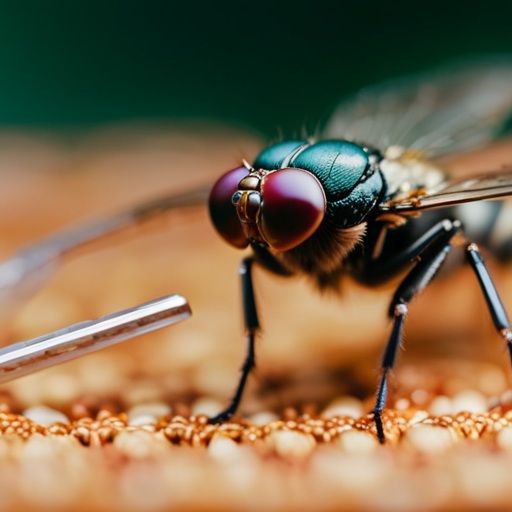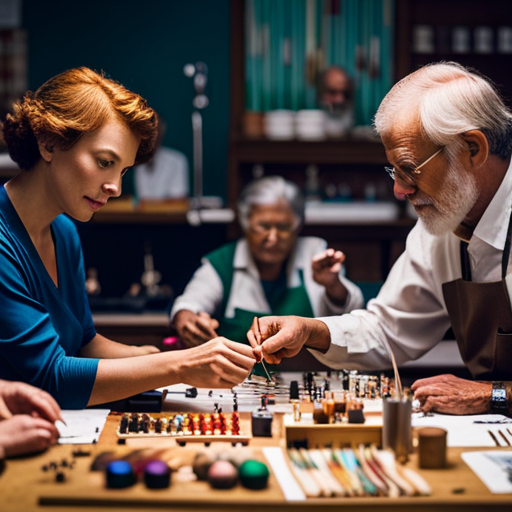As the delicate dance of feathers and fur come together to create intricate fly patterns, capturing the art of fly tying through photography and videography is a skill that requires precision and attention to detail.
In this article, we will explore the essential techniques and equipment needed to document the beauty and complexity of fly tying, from close-up shots to editing and sharing your work with the fly tying community.
Essential Equipment for Photography
The essential equipment for fly tying photography includes a high-quality DSLR camera with a macro lens and a sturdy tripod for stable, clear shots. When selecting a lens for fly tying photography, a macro lens is crucial due to its ability to capture fine details and intricate patterns.
The camera settings are also important to consider. In fly tying photography, a narrow aperture (higher f-stop) is typically preferred to ensure a greater depth of field, keeping the entire fly and background in focus. Adjusting the ISO to the lowest possible setting reduces digital noise, ensuring high-quality, sharp images. Utilizing manual focus allows for precise control over the focal point, ensuring the fly’s intricate details are captured sharply.
Additionally, the use of a remote shutter release or the camera’s self-timer can help minimize camera shake and ensure the sharpest possible images. By carefully considering lens selection and camera settings, fly tying enthusiasts can capture stunning, detailed photographs of their meticulously crafted flies.
Lighting and Composition Techniques
When photographing fly tying creations, achieving optimal lighting and composition techniques is essential for capturing the intricate details and textures with precision and clarity. To ensure the best results, consider the following key factors:
-
Natural vs Artificial Lighting: Experiment with both natural and artificial lighting to determine which works best for highlighting the fine details of the fly tying creations. Natural light can bring out the natural colors and textures, while artificial light sources such as softboxes or diffusers can provide controlled lighting for consistent results.
-
Framing Techniques: Explore different framing techniques to showcase the fly tying creations in the most visually appealing way. Consider using close-up shots to emphasize the intricate details, or experiment with various angles to capture the depth and dimension of the flies.
-
Macro Lens and Rule of Thirds for Composition: Utilize a macro lens to capture the fine details and textures of the fly tying creations with exceptional clarity. Additionally, apply the rule of thirds for composition to create visually balanced and engaging photographs that draw the viewer’s attention to the focal points of the flies.
Capturing Details in Close-up Shots
Achieving optimal lighting and composition techniques is crucial when capturing close-up shots of fly tying creations to highlight their intricate details and textures with precision and clarity. When capturing close-up shots, using a macro lens is essential to ensure that the smallest details are captured with clarity. A macro lens allows for a high level of magnification, enabling the photographer to focus on the tiniest elements of the fly tying creations. Additionally, understanding the concept of depth of field is crucial. A shallow depth of field can be used to isolate specific details, such as the delicate fibers of the materials used in the fly tying process, while a deeper depth of field may be necessary to ensure that the entire fly pattern is in focus.
Texture contrast is another vital consideration when capturing close-up shots. Utilizing the right focal length can emphasize the contrasting textures present in the fly tying materials, such as the smoothness of feathers against the roughness of synthetic materials. By carefully selecting the focal length, photographers can create visually striking images that showcase the intricate textures of the fly patterns. The table below summarizes the key considerations for capturing details in close-up shots:
| Key Consideration | Description |
|---|---|
| Macro lens | Essential for capturing tiny details with clarity and precision. |
| Depth of field | Understanding the concept is crucial for isolating specific details or ensuring the entire pattern is in focus. |
| Texture contrast | Emphasizing the contrasting textures present in the fly tying materials. |
Tips for Shooting Fly Tying Videos
To effectively capture the intricate process of fly tying in videos, employing professional videography techniques is essential to showcase the craftsmanship and detail involved.
When shooting fly tying videos, the following tips can help ensure high-quality and engaging content:
-
Camera Angles: Experiment with various camera angles to provide viewers with different perspectives of the fly tying process. Close-up shots can highlight intricate details, while wide shots can show the overall technique and movements involved. Utilizing overhead shots can also offer a unique viewpoint, capturing the entire tying area and demonstrating the step-by-step progression.
-
Lighting: Proper lighting is crucial for capturing the fine details of fly tying. Utilize diffused natural light or artificial lighting sources to minimize harsh shadows and ensure clarity in the video. Adjust the lighting to highlight the materials and the tying process without overwhelming the viewer with excessive brightness.
-
Audio Recording: Pay attention to audio recording to capture clear, high-quality sound. Utilize external microphones to minimize ambient noise and ensure that the instructions and explanations are clearly heard, enhancing the overall viewing experience. Good audio quality is essential for engaging and informative fly tying videos.
Editing and Sharing Your Tying Documentation
After completing the photography and videography of fly tying, the next step is to edit and share the documentation with a wider audience. Editing tips are essential to ensure that your content is engaging and informative. Consider adding captions, annotations, and close-up shots to highlight intricate details. Additionally, using editing software to enhance colors and adjust lighting can significantly improve the overall quality of your documentation.
When it comes to sharing your fly tying documentation, there are several online platforms that cater to this niche interest. Utilizing platforms such as YouTube, Vimeo, or specialized fly tying forums allows you to reach a community of fellow enthusiasts. Social media platforms like Instagram and Facebook are also effective for sharing shorter clips or snapshots of your tying process. Engaging with the audience through comments and responding to queries further enhances the sharing experience.
To provide a clear comparison of online platforms for sharing fly tying documentation, consider the following table:
| Platform | Advantages |
|---|---|
| YouTube | Large audience reach, video analytics |
| Vimeo | High-quality video hosting, customization |
| Fly Tying Forums | Targeted audience, community engagement |
Remember to leverage these platforms’ features to maximize the impact of your documentation and connect with a broader audience.
Frequently Asked Questions
How Can I Effectively Capture the Movement and Action of Tying a Fly in My Videos?
To effectively capture the movement and action of tying a fly in videos, utilize professional lighting techniques and thoughtful composition. Consider incorporating slow motion or time-lapse sequences to showcase intricate details and dynamic processes with precision and clarity.
What Are Some Creative Ways to Incorporate Different Angles and Perspectives in My Fly Tying Photography?
To achieve striking fly tying photography, explore alternative angles and perspectives for a visually dynamic portrayal. Utilize different lighting techniques to enhance depth and texture, experiment with macro shots, and incorporate creative backgrounds to captivate the viewer’s attention.
Are There Any Specific Tips for Capturing the Intricate Details of Different Fly Tying Materials in Close-Up Shots?
Capturing textures and intricate details of fly tying materials in close-up shots requires a meticulous approach. Utilize macro photography techniques, such as close-up lighting and focus stacking, to highlight the fine nuances of each material.
How Can I Ensure That the Colors of the Flies I Photograph Accurately Represent Their True Appearance?
To ensure accurate color representation in fly photographs, meticulous attention to lighting is crucial. Utilize color swatches to calibrate white balance and achieve true colors. Consistent, natural lighting and proper white balance settings are fundamental for color accuracy.
What Are Some Effective Techniques for Adding Music and Other Audio Elements to My Fly Tying Videos to Enhance the Viewer’s Experience?
Incorporating well-selected music, ambient sounds, and skillful audio editing can greatly enhance the viewer’s experience in fly tying videos. Thoughtful storytelling through audio elements can create a more engaging and immersive viewing experience.
Conclusion
In conclusion, documenting the art of fly tying through photography and videography is akin to capturing the delicate dance of a butterfly in flight.
With the right equipment, lighting, and composition techniques, one can immortalize the intricate details and movements of this timeless craft.
By mastering the art of close-up shots and video editing, one can share the beauty and skill of fly tying with the world, preserving this art form for future generations to admire and learn from.




